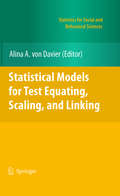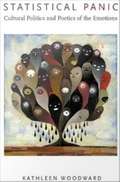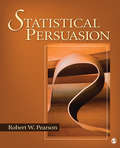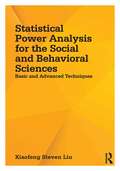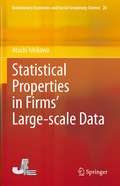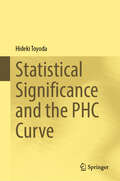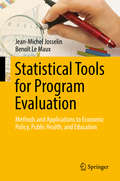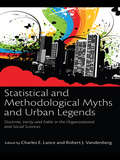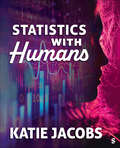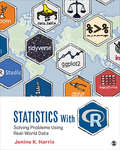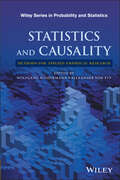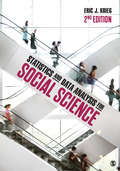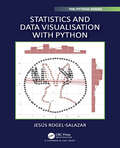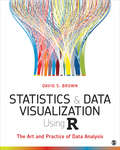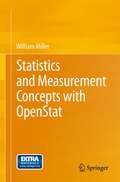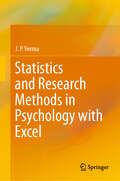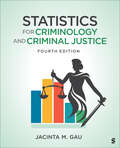- Table View
- List View
Statistical Models and Causal Inference
by David A. FreedmanDavid A. Freedman presents here a definitive synthesis of his approach to causal inference in the social sciences. He explores the foundations and limitations of statistical modeling, illustrating basic arguments with examples from political science, public policy, law, and epidemiology. Freedman maintains that many new technical approaches to statistical modeling constitute not progress, but regress. Instead, he advocates a 'shoe leather' methodology, which exploits natural variation to mitigate confounding and relies on intimate knowledge of the subject matter to develop meticulous research designs and eliminate rival explanations. When Freedman first enunciated this position, he was met with scepticism, in part because it was hard to believe that a mathematical statistician of his stature would favor 'low-tech' approaches. But the tide is turning. Many social scientists now agree that statistical technique cannot substitute for good research design and subject matter knowledge. This book offers an integrated presentation of Freedman's views.
Statistical Models for Data Analysis
by Paolo Giudici Maurizio Vichi Salvatore IngrassiaThe papers in this book cover issues related to the development of novel statistical models for the analysis of data. They offer solutions for relevant problems in statistical data analysis and contain the explicit derivation of the proposed models as well as their implementation. The book assembles the selected and refereed proceedings of the biannual conference of the Italian Classification and Data Analysis Group (CLADAG), a section of the Italian Statistical Society.
Statistical Models for Test Equating, Scaling, and Linking
by Alina A. DavierThe goal of this book is to emphasize the formal statistical features of the practice of equating, linking, and scaling. The book encourages the view and discusses the quality of the equating results from the statistical perspective (new models, robustness, fit, testing hypotheses, statistical monitoring) as opposed to placing the focus on the policy and the implications, which although very important, represent a different side of the equating practice. The book contributes to establishing "equating" as a theoretical field, a view that has not been offered often before. The tradition in the practice of equating has been to present the knowledge and skills needed as a craft, which implies that only with years of experience under the guidance of a knowledgeable practitioner could one acquire the required skills. This book challenges this view by indicating how a good equating framework, a sound understanding of the assumptions that underlie the psychometric models, and the use of statistical tests and statistical process control tools can help the practitioner navigate the difficult decisions in choosing the final equating function. This book provides a valuable reference for several groups: (a) statisticians and psychometricians interested in the theory behind equating methods, in the use of model-based statistical methods for data smoothing, and in the evaluation of the equating results in applied work; (b) practitioners who need to equate tests, including those with these responsibilities in testing companies, state testing agencies, and school districts; and (c) instructors in psychometric, measurement, and psychology programs.
Statistical Panic: Cultural Politics and Poetics of the Emotions
by Kathleen WoodwardIn this moving and thoughtful book, Kathleen Woodward explores the politics and poetics of the emotions, focusing on American culture since the 1960s. She argues that we are constrained in terms of gender, race, and age by our culture's scripts for "emotional" behavior and that the accelerating impoverishment of interiority is a symptom of our increasingly media-saturated culture. She also shows how we can be empowered by stories that express our experience, revealing the value of our emotions as a crucial form of intelligence. Referring discreetly to her own experience, Woodward examines the interpenetration of social structures and subjectivity, considering how psychological emotions are social phenomena, with feminist anger, racial shame, old-age depression, and sympathy for non-human cyborgs (including robots) as key cases in point. She discusses how emerging institutional and discursive structures engender "new" affects that in turn can help us understand our changing world if we are attentive to them--the "statistical panic" produced by the risk society, with its numerical portents of disease and mortality; the rage prompted by impenetrable and bloated bureaucracies; the brutal shame experienced by those caught in the crossfire of the media; and the conservative compassion that is not an emotion at all, only an empty political slogan. The orbit of Statistical Panic is wide, drawing in feminist theory, critical phenomenology, and recent theories of the emotions. But at its heart are stories. As an antidote to the vacuous dramas of media culture, with its mock emotions and scattershot sensations, Woodward turns to the autobiographical narrative. Stories of illness--by Joan Didion, Yvonne Rainer, Paul Monette, and Alice Wexler, among others--receive special attention, with the inexhaustible emotion of grief framing the book as a whole.
Statistical Persuasion: How to Collect, Analyze, and Present Data...Accurately, Honestly, and Persuasively
by Dr Robert W. PearsonThis text clearly and straightforwardly demonstrates how to collect, manage, analyze, and present data in real world applications in education, criminal justice and other fields in the social sciences.
Statistical Power Analysis for the Social and Behavioral Sciences: Basic and Advanced Techniques
by Xiaofeng Steven LiuThis is the first book to demonstrate the application of power analysis to the newer more advanced statistical techniques that are increasingly used in the social and behavioral sciences. Both basic and advanced designs are covered. Readers are shown how to apply power analysis to techniques such as hierarchical linear modeling, meta-analysis, and structural equation modeling. Each chapter opens with a review of the statistical procedure and then proceeds to derive the power functions. This is followed by examples that demonstrate how to produce power tables and charts. The book clearly shows how to calculate power by providing open code for every design and procedure in R, SAS, and SPSS. Readers can verify the power computation using the computer programs on the book's website. There is a growing requirement to include power analysis to justify sample sizes in grant proposals. Most chapters are self-standing and can be read in any order without much disruption.This book will help readers do just that. Sample computer code in R, SPSS, and SAS at www.routledge.com/9781848729810 are written to tabulate power values and produce power curves that can be included in a grant proposal. Organized according to various techniques, chapters 1 – 3 introduce the basics of statistical power and sample size issues including the historical origin, hypothesis testing, and the use of statistical power in t tests and confidence intervals. Chapters 4 - 6 cover common statistical procedures -- analysis of variance, linear regression (both simple regression and multiple regression), correlation, analysis of covariance, and multivariate analysis. Chapters 7 - 11 review the new statistical procedures -- multi-level models, meta-analysis, structural equation models, and longitudinal studies. The appendixes contain a tutorial about R and show the statistical theory of power analysis. Intended as a supplement for graduate courses on quantitative methods, multivariate statistics, hierarchical linear modeling (HLM) and/or multilevel modeling and SEM taught in psychology, education, human development, nursing, and social and life sciences, this is the first text on statistical power for advanced procedures. Researchers and practitioners in these fields also appreciate the book‘s unique coverage of the use of statistical power analysis to determine sample size in planning a study. A prerequisite of basic through multivariate statistics is assumed.
Statistical Power Analysis with Missing Data: A Structural Equation Modeling Approach
by Adam Davey Jyoti "Tina" SavlaStatistical power analysis has revolutionized the ways in which we conduct and evaluate research. Similar developments in the statistical analysis of incomplete (missing) data are gaining more widespread applications. This volume brings statistical power and incomplete data together under a common framework, in a way that is readily accessible to those with only an introductory familiarity with structural equation modeling. It answers many practical questions such as: How missing data affects the statistical power in a study How much power is likely with different amounts and types of missing data How to increase the power of a design in the presence of missing data, and How to identify the most powerful design in the presence of missing data. Points of Reflection encourage readers to stop and test their understanding of the material. Try Me sections test one’s ability to apply the material. Troubleshooting Tips help to prevent commonly encountered problems. Exercises reinforce content and Additional Readings provide sources for delving more deeply into selected topics. Numerous examples demonstrate the book’s application to a variety of disciplines. Each issue is accompanied by its potential strengths and shortcomings and examples using a variety of software packages (SAS, SPSS, Stata, LISREL, AMOS, and MPlus). Syntax is provided using a single software program to promote continuity but in each case, parallel syntax using the other packages is presented in appendixes. Routines, data sets, syntax files, and links to student versions of software packages are found at www.psypress.com/davey. The worked examples in Part 2 also provide results from a wider set of estimated models. These tables, and accompanying syntax, can be used to estimate statistical power or required sample size for similar problems under a wide range of conditions. Class-tested at Temple, Virginia Tech, and Miami University of Ohio, this brief text is an ideal supplement for graduate courses in applied statistics, statistics II, intermediate or advanced statistics, experimental design, structural equation modeling, power analysis, and research methods taught in departments of psychology, human development, education, sociology, nursing, social work, gerontology and other social and health sciences. The book’s applied approach will also appeal to researchers in these areas. Sections covering Fundamentals, Applications, and Extensions are designed to take readers from first steps to mastery.
Statistical Programming in SAS
by A. John BailerStatistical Programming in SAS Second Edition provides a foundation for programming to implement statistical solutions using SAS, a system that has been used to solve data analytic problems for more than 40 years. The author includes motivating examples to inspire readers to generate programming solutions. Upper-level undergraduates, beginning graduate students, and professionals involved in generating programming solutions for data-analytic problems will benefit from this book. The ideal background for a reader is some background in regression modeling and introductory experience with computer programming. The coverage of statistical programming in the second edition includes Getting data into the SAS system, engineering new features, and formatting variables Writing readable and well-documented code Structuring, implementing, and debugging programs that are well documented Creating solutions to novel problems Combining data sources, extracting parts of data sets, and reshaping data sets as needed for other analyses Generating general solutions using macros Customizing output Producing insight-inspiring data visualizations Parsing, processing, and analyzing text Programming solutions using matrices and connecting to R Processing text Programming with matrices Connecting SAS with R Covering topics that are part of both base and certification exams.
Statistical Properties in Firms’ Large-scale Data (Evolutionary Economics and Social Complexity Science #26)
by Atushi IshikawaThis is the first book to provide a systematic description of statistical properties of large-scale financial data. Specifically, the power-law and log-normal distributions observed at a given time and their changes using time-reversal symmetry, quasi-time-reversal symmetry, Gibrat's law, and the non-Gibrat's property observed in a short-term period are derived here. The statistical properties observed over a long-term period, such as power-law and exponential growth, are also derived. These subjects have not been thoroughly discussed in the field of economics in the past, and this book is a compilation of the author's series of studies by reconstructing the data analyses published in 15 academic journals with new data. This book provides readers with a theoretical and empirical understanding of how the statistical properties observed in firms’ large-scale data are related along the time axis. It is possible to expand this discussion to understand theoretically and empirically how the statistical properties observed among differing large-scale financial data are related. This possibility provides readers with an approach to microfoundations, an important issue that has been studied in economics for many years.
Statistical Significance and the PHC Curve
by Hideki ToyodaThis book explains the importance of using the probability that the hypothesis is correct (PHC), an intuitive measure that anyone can understand, as an alternative to the p-value. In order to overcome the “reproducibility crisis” caused by the misuse of significance tests, this book provides a detailed explanation of the mechanism of p-hacking using significance tests, and concretely shows the merits of PHC as an alternative to p-values. In March 2019, two impactful papers on statistics were published. One paper, "Moving to a World Beyond ‘p The American Statistician, overseen by the American Statistical Association. The title of the first chapter is “Don't Say ‘Statistically Significant’”, and it uses the imperative form to clearly forbid the use of significance testing. Another paper, “Retire statistical significance”, was published in the prestigious scientific journal Nature. This commentary was endorsed by more than 800 scientists, advocating for the statement, “We agree, and call for the entire concept of statistical significance to be abandoned.” Consider a study comparing the duration of hospital stays between treatments A and B. Previously, research conclusions were typically stated as: “There was a statistically significant difference at the 5% level in the average duration of hospital stays.” This phrasing is quite abstract. Instead, we present the following conclusion as an example: (1) The average duration of hospital stays for Group A is at least half a day shorter than for Group B. (2) 71% of patients in Group A have shorter hospital stays than the average for Group B. (3) Group A has an average hospital stay that is, on average, no more than 94% of that of Group B. Then, the probability that the expression is correct is shown. That is the PHC curve.
Statistical Tools for Program Evaluation: Methods and Applications to Economic Policy, Public Health, and Education
by Jean-Michel Josselin Benoît Le MauxThis book provides a self-contained presentation of the statistical tools required for evaluating public programs, as advocated by many governments, the World Bank, the European Union, and the Organization for Economic Cooperation and Development. After introducing the methodological framework of program evaluation, the first chapters are devoted to the collection, elementary description and multivariate analysis of data as well as the estimation of welfare changes. The book then successively presents the tools of ex-ante methods (financial analysis, budget planning, cost-benefit, cost-effectiveness and multi-criteria evaluation) and ex-post methods (benchmarking, experimental and quasi-experimental evaluation). The step-by-step approach and the systematic use of numerical illustrations equip readers to handle the statistics of program evaluation. It not only offers practitioners from public administrations, consultancy firms and nongovernmental organizations the basic tools and advanced techniques used in program assessment, it is also suitable for executive management training, upper undergraduate and graduate courses, as well as for self-study.
Statistical and Methodological Myths and Urban Legends: Doctrine, Verity and Fable in Organizational and Social Sciences
by Charles E. LanceThis book provides an up-to-date review of commonly undertaken methodological and statistical practices that are sustained, in part, upon sound rationale and justification and, in part, upon unfounded lore. Some examples of these "methodological urban legends", as we refer to them in this book, are characterized by manuscript critiques such as: (a) "your self-report measures suffer from common method bias"; (b) "your item-to-subject ratios are too low"; (c) "you can’t generalize these findings to the real world"; or (d) "your effect sizes are too low". Historically, there is a kernel of truth to most of these legends, but in many cases that truth has been long forgotten, ignored or embellished beyond recognition. This book examines several such legends. Each chapter is organized to address: (a) what the legend is that "we (almost) all know to be true"; (b) what the "kernel of truth" is to each legend; (c) what the myths are that have developed around this kernel of truth; and (d) what the state of the practice should be. This book meets an important need for the accumulation and integration of these methodological and statistical practices.
Statistics With Humans
by Katie A. JacobsStatistics With Humans teaches depth of understanding and application of foundational concepts in statistics for the social and behavioral sciences. By translating her passion and energy for teaching into the book, author Katie Jacobs makes statistics approachable and understandable for even the most math-phobic student. Drawing on examples from students’ everyday lives and written in a friendly and conversational tone, with eye-catching full-color photos, this book both offers lots of practice opportunities, and speaks to today′s students. The book focuses on the application concepts but can also be used by those teaching with SPSS as it includes directions for using SPSS and SPSS walkthrough videos created by the author. This text is also available in Sage Vantage, an easy-to-use learning platform that offers practice problems, end-of-chapter quizzes, author key concept videos, data activities, and other interactive tools to support student learning.
Statistics With Humans
by Katie A. JacobsStatistics With Humans teaches depth of understanding and application of foundational concepts in statistics for the social and behavioral sciences. By translating her passion and energy for teaching into the book, author Katie Jacobs makes statistics approachable and understandable for even the most math-phobic student. Drawing on examples from students’ everyday lives and written in a friendly and conversational tone, with eye-catching full-color photos, this book both offers lots of practice opportunities, and speaks to today′s students. The book focuses on the application concepts but can also be used by those teaching with SPSS as it includes directions for using SPSS and SPSS walkthrough videos created by the author. This text is also available in Sage Vantage, an easy-to-use learning platform that offers practice problems, end-of-chapter quizzes, author key concept videos, data activities, and other interactive tools to support student learning.
Statistics With R: Solving Problems Using Real-World Data
by Jenine K. HarrisDrawing on examples from across the social and behavioral sciences, Statistics with R: Solving Problems Using Real-World Data by Jenine K. Harris introduces foundational statistics concepts with beginner-friendly R programming in an exploration of the world&’s tricky problems faced by the &“R Team&” characters. Inspired by the programming group &“R Ladies,&” the R Team works together to master the skills of statistical analysis and data visualization to untangle real-world, messy data using R. The storylines draw students into investigating contemporary issues such as marijuana legalization, voter registration, and the opioid epidemic, and lead them step-by-step through full-color illustrations of R statistics and interactive exercises.
Statistics With R: Solving Problems Using Real-World Data
by Jenine K. HarrisDrawing on examples from across the social and behavioral sciences, Statistics with R: Solving Problems Using Real-World Data by Jenine K. Harris introduces foundational statistics concepts with beginner-friendly R programming in an exploration of the world&’s tricky problems faced by the &“R Team&” characters. Inspired by the programming group &“R Ladies,&” the R Team works together to master the skills of statistical analysis and data visualization to untangle real-world, messy data using R. The storylines draw students into investigating contemporary issues such as marijuana legalization, voter registration, and the opioid epidemic, and lead them step-by-step through full-color illustrations of R statistics and interactive exercises.
Statistics and Causality: Methods for Applied Empirical Research
by Alexander Von Eye Wolfgang WiedermannA one-of-a-kind guide to identifying and dealing with modern statistical developments in causality Written by a group of well-known experts, Statistics and Causality: Methods for Applied Empirical Research focuses on the most up-to-date developments in statistical methods in respect to causality. Illustrating the properties of statistical methods to theories of causality, the book features a summary of the latest developments in methods for statistical analysis of causality hypotheses. The book is divided into five accessible and independent parts. The first part introduces the foundations of causal structures and discusses issues associated with standard mechanistic and difference-making theories of causality. The second part features novel generalizations of methods designed to make statements concerning the direction of effects. The third part illustrates advances in Granger-causality testing and related issues. The fourth part focuses on counterfactual approaches and propensity score analysis. Finally, the fifth part presents designs for causal inference with an overview of the research designs commonly used in epidemiology. Statistics and Causality: Methods for Applied Empirical Research also includes: * New statistical methodologies and approaches to causal analysis in the context of the continuing development of philosophical theories * End-of-chapter bibliographies that provide references for further discussions and additional research topics * Discussions on the use and applicability of software when appropriate Statistics and Causality: Methods for Applied Empirical Research is an ideal reference for practicing statisticians, applied mathematicians, psychologists, sociologists, logicians, medical professionals, epidemiologists, and educators who want to learn more about new methodologies in causal analysis. The book is also an excellent textbook for graduate-level courses in causality and qualitative logic. Wolfgang Wiedermann, PhD, is Assistant Professor in the Department of Educational, School, and Counseling Psychology at the University of Missouri, Columbia. His research interests include the development of methods for direction dependence analysis and causal inference, the development and evaluation of methods for person-oriented research, and methods for intensive longitudinal data. Alexander von Eye, PhD, is Professor Emeritus of Psychology at Michigan State University. His research interests include statistical methods, categorical data analysis, and human development. Dr. von Eye is Section Editor for the Encyclopedia of Statistics in Behavioral Science and is the coauthor of Log-Linear Modeling: Concepts, Interpretation, and Application, both published by Wiley.
Statistics and Data Analysis for Social Science
by Eric Jon KriegStatistics and Data Analysis for Social Science helps students to build a strong foundational understanding of statistics by providing clarity around when and why statistics useful. Rather than focusing on the “how to” of statistics, author Eric J. Krieg simplifies the complexity of statistical calculations by introducing only what is necessary to understanding each concept. Every chapter is written around and applied to a different social problem or issues—enabling students to broaden their imagination about the statistical “tools” that can be used to make sense of our world and, maybe, to make the world a better place.
Statistics and Data Analysis for Social Science
by Eric Jon KriegStatistics and Data Analysis for Social Science helps students to build a strong foundational understanding of statistics by providing clarity around when and why statistics useful. Rather than focusing on the “how to” of statistics, author Eric J. Krieg simplifies the complexity of statistical calculations by introducing only what is necessary to understanding each concept. Every chapter is written around and applied to a different social problem or issues—enabling students to broaden their imagination about the statistical “tools” that can be used to make sense of our world and, maybe, to make the world a better place.
Statistics and Data Visualisation with Python (Chapman & Hall/CRC The Python Series)
by Jesus Rogel-SalazarThis book is intended to serve as a bridge in statistics for graduates and business practitioners interested in using their skills in the area of data science and analytics as well as statistical analysis in general. On the one hand, the book is intended to be a refresher for readers who have taken some courses in statistics, but who have not necessarily used it in their day-to-day work. On the other hand, the material can be suitable for readers interested in the subject as a first encounter with statistical work in Python. Statistics and Data Visualisation with Python aims to build statistical knowledge from the ground up by enabling the reader to understand the ideas behind inferential statistics and begin to formulate hypotheses that form the foundations for the applications and algorithms in statistical analysis, business analytics, machine learning, and applied machine learning. This book begins with the basics of programming in Python and data analysis, to help construct a solid basis in statistical methods and hypothesis testing, which are useful in many modern applications.
Statistics and Data Visualization Using R: The Art and Practice of Data Analysis
by David S. BrownDesigned to introduce students to quantitative methods in a way that can be applied to all kinds of data in all kinds of situations, Statistics and Data Visualization Using R: The Art and Practice of Data Analysis by David S. Brown teaches students statistics through charts, graphs, and displays of data that help students develop intuition around statistics as well as data visualization skills. By focusing on the visual nature of statistics instead of mathematical proofs and derivations, students can see the relationships between variables that are the foundation of quantitative analysis. Using the latest tools in R and R RStudio® for calculations and data visualization, students learn valuable skills they can take with them into a variety of future careers in the public sector, the private sector, or academia. Starting at the most basic introduction to data and going through most crucial statistical methods, this introductory textbook quickly gets students new to statistics up to speed running analyses and interpreting data from social science research.
Statistics and Data Visualization Using R: The Art and Practice of Data Analysis
by David S. BrownDesigned to introduce students to quantitative methods in a way that can be applied to all kinds of data in all kinds of situations, Statistics and Data Visualization Using R: The Art and Practice of Data Analysis by David S. Brown teaches students statistics through charts, graphs, and displays of data that help students develop intuition around statistics as well as data visualization skills. By focusing on the visual nature of statistics instead of mathematical proofs and derivations, students can see the relationships between variables that are the foundation of quantitative analysis. Using the latest tools in R and R RStudio® for calculations and data visualization, students learn valuable skills they can take with them into a variety of future careers in the public sector, the private sector, or academia. Starting at the most basic introduction to data and going through most crucial statistical methods, this introductory textbook quickly gets students new to statistics up to speed running analyses and interpreting data from social science research.
Statistics and Measurement Concepts with OpenStat
by William MillerThis reference manual for the OpenStat software, an open-source software developed by William Miller, covers a broad spectrum of statistical methods and techniques. A unique feature is its compatibility with many other statistical programs. OpenStat users are researchers and students in the social sciences, education, or psychology, who benefit from the hands on approach to Statistics. During and upon completion of courses in Statistics or measurement, students and future researchers need a low cost computer program available to them, and OpenStat fills this void. The software is used in Statistics courses around the world with over 50,000 downloads per year. The manual covers all functions of the OpenStat software, including measurement, ANOVAS, regression analyses, simulations, product-moment and partial correlations, and logistic regression. The manual is an important learning tool that explains the Statistics behind the many analyses possible with the program and demonstrates these analyses.
Statistics and Research Methods in Psychology with Excel
by J.P. VermaThis book, specifically developed for students of psychology, covers a wide range of topics in statistics and research designs taught in psychology, in particular, and other disciplines like management, sociology, education, home science, and nutrition, in general, in most universities. It explains how to use Excel to analyze research data by elaborating statistical concepts. Each chapter contains sections like “Check you Computing skill” and “Check your Statistical Concepts” to enable students to assess their knowledge in a graded manner. The book addresses one of the major challenges in psychology research, viz., how to measure subjective phenomenon like attitude, desire, and preferences of an individual. Separate emphasis has been given to the measurement techniques which are essential tools to assess these subjective parameters in numerical form, required for statistical analysis to draw meaningful conclusions. The book is equally helpful to students of humanities, life sciences and other applied areas. Consisting of 14 chapters, the book covers all relevant topics of statistics and research designs which are important for students to plan and complete their research work.
Statistics for Criminology and Criminal Justice
by Jacinta M. GauStatistics for Criminology and Criminal Justice, Fourth Edition demonstrates the relevancy of statistics in an age of artificial intelligence (AI), deep fakes, and misinformation by helping students ask the right questions so that they can be open-minded but sufficiently skeptical. Jacinta M. Gau uses conversational language to break down complicated concepts, presents statistical tests step by step, and uses SPSS to guide students through obtaining and interpreting output. New to the Fourth Edition are updated examples including the #MeToo and racial justice movements’ impact on the criminal justice system, implications of AI for fraud and cybercrime, and the increasing prevalence of mass casualty events. New data sets are provided, and many Critical Thinking Questions, Learning Checks, Chapter Review Questions have been expanded and updated. These changes reflect a commitment to making statistics more approachable and engaging for students, with a focus on real-world applications and critical thinking.


